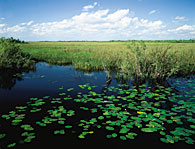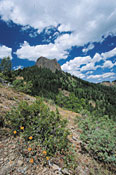|
Mining, Lack of Independent Review Threaten Everglades Restoration | Monumental Support Needed
Mining, Lack of Independent Review Threaten Everglades Restoration
By Laura Fauth
 "The Everglades is a test," said the late author and activist Marjory Stoneman Douglas, known for her tireless efforts to protect Florida's unique wetlands. "If we pass, we get to keep the planet." "The Everglades is a test," said the late author and activist Marjory Stoneman Douglas, known for her tireless efforts to protect Florida's unique wetlands. "If we pass, we get to keep the planet."
If the Everglades is a test, it appeared we might get a passing grade when, in 2000, a $7.8 billion plan to restore the south Florida ecosystem was signed into law by President Bill Clinton. The goals of the Comprehensive Everglades Restoration Plan included purchasing and protecting additional wetlands acre-age and restoring a more natural water flow to the Everglades. It was heralded as the largest environmental project in American history and a national model for future restorations.
But two years after the plan's passage, we may already be in danger of failing. In April, the Army Corps of Engineers-the agency in charge of the restoration-approved deep-pit limestone mining on more than 5,000 acres of Everglades wetlands, the first phase in a proposal to allow rock mining on more than 21,000 acres of Everglades' wetlands.
"You can't destroy 21,000 acres of the Everglades at the same time you are claiming to restore it," says Frank Jackalone, Florida representative for the Sierra Club. Department of the Interior reviewers have stated that "the size, habitat type, and location" of the proposed mining area "makes it critical to the ecological integrity of the Everglades ecosystem," and the Corps predicted that the mining would have an "irreversible" impact.
Nonetheless, the Corps is promoting the mining as a key element of the restoration on the grounds that once some of the rock pits are mined out, two of them will be converted into water storage reservoirs, including one for additional flows to Everglades National Park.
But according to Barbara Lange, Everglades co-chair for the Florida Chapter, "the limestone is more porous than Swiss cheese and no one has the faintest idea whether the pits will hold water." Even government scientists and engineers are concerned that the 80-foot deep mining pits could "suck water out of the Everglades, implode, or taint Miami's drinking water with deadly cryptosporidium," according to a series of articles in the Washington Post.
In August, the Sierra Club, the Natural Resources Defense Council, and the National Parks Conservation Association sued the Corps to overturn the mining decision. The groups believe the decision violates the Endangered Species Act, the Clean Water Act, and the National Environmental Policy Act.
The lawsuit also targets U.S. Fish and Wildlife for failing to protect the endangered wood stork. A recent study by the South Florida Water Management District found that 1,400 of the park's 1,600 storks nest within five miles of the proposed mining area.
In addition to the wood stork, 13 species that depend on the Everglades for survival are endangered, including the Florida panther and the American crocodile, and 90 percent of the Everglades' wading birds have disappeared. Half of the Everglades has been paved for development or drained for agriculture.
Pressure from commercial interests threatens to put the entire Everglades restoration project at risk, says Jackalone. Newspapers have reported more than $800,000 worth of political contributions by mining companies and their executives in the last five years. And, although Florida already leads the national in per-capita water consumption, there is pressure to expand water supply for south Florida's businesses and residents.
With all the political pressure, "independent scientific review of the project is the only way to check the work of the Corps," says Jonathan Ullman, a Sierra Club Florida representative. "We don't want to end up with an $8 billion boondoggle mining and water supply plan that has no benefits for the Everglades."
The plan's programmatic regulations, which determine how the plan will be carried out, do not include review by an independent scientific panel. Senators James Jeffords (I-Vt.), Bob Graham (D-Fla.), Bill Nelson (D-Fla.), George Voinovich (R-Ohio), and Bob Smith (R-N.H.) have signed a letter calling for a re-vamping of the programmatic regulations, starting with inclusion of independent scientific review.
Contact your senators and representative with a personal message. Express your outrage at the Corps of Engineers' approval of limestone mining in the Everglades simultaneous with a $7.8 billion dollar taxpayer-supported restoration plan. Ask them to support independent scientific review as an essential component of the Comprehensive Everglades Restoration Plan.
Monumental Support Needed
By Tom Valtin
 Cascade-Siskiyou National Monument in southern Oregon is the nation's first national monument designated in recognition of an area's biological diversity. The rugged, mountainous region displays ecological characteristics of the Cascade Range to the north, the Great Basin to the east, and the Siskiyou Mountains that stretch south into California. Cascade-Siskiyou National Monument in southern Oregon is the nation's first national monument designated in recognition of an area's biological diversity. The rugged, mountainous region displays ecological characteristics of the Cascade Range to the north, the Great Basin to the east, and the Siskiyou Mountains that stretch south into California.
But continuing solid public support for real protection of the monument is crucial in order to prevent damage from boundary adjustments, logging, illegal off-road vehicle use, and grazing. Monument supporters should let the Bureau of Land Management know they want strong protections. Public comments on the BLM's Draft Management Plan are due December 18.
Write to the U.S. Bureau of Land Management, Medford District Office, 3040 Biddle Road, Medford, OR 97504. For more information or to submit your comments online, go to www.sierraclub.org/wildlands/monuments/cascade.asp.
Up to Top
|